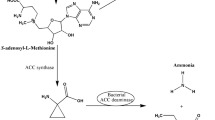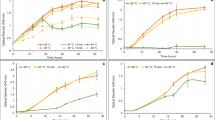Abstract
Ethylene acts as a major regulator of the nodulation process of leguminous plants. Several rhizobial strains possess the ability to modulate plant ethylene levels through the expression of the enzyme 1-aminocyclopropane-1-carboxylate (ACC) deaminase; however, rhizobia present low enzymatic activities. One possible alternative to this problem resides on the use of free-living bacteria, such as Pseudomonas, presenting high levels of ACC deaminase activity that may be used as adjuvants in the nodulation process by decreasing inhibitory ethylene levels. Nevertheless, not much is understood about the specific role of ACC deaminase in the possible role of free-living bacteria as nodulation adjuvants. Therefore, this work aims to study the effect of ACC deaminase in the plant growth-promoting bacterium, Pseudomonas fluorescens YsS6, ability to facilitate alpha- and beta-rhizobia nodulation. The ACC deaminase-producing P. fluorescens YsS6 and its ACC deaminase mutant were used in co-inoculation assays to evaluate their impact in the nodulation process of alpha- (Rhizobium tropici CIAT899) and beta-rhizobia (Cupriavidus taiwanensis STM894) representatives, in Phaseolus vulgaris and Mimosa pudica plants, respectively. The results obtained indicate that the wild-type P. fluorescens YsS6, but not its mutant defective in ACC deaminase production, increase the nodulation abilities of both alpha- and beta-rhizobia, resulting in an increased leguminous plant growth. Moreover, this is the first report of the positive effect of free-living bacteria in the nodulation process of beta-rhizobia. The modulation of inhibitory ethylene levels by free-living ACC deaminase-producing bacteria plays an important role in facilitating the nodulation process of alpha- and beta-rhizobia.


Similar content being viewed by others
References
Ali S, Charles TC, Glick BR (2014) Amelioration of high salinity stress damage by plant growth-promoting bacterial endophytes that contain ACC deaminase. Plant Physiol Biochem 80:160–167
Belimov AA, Dodd IC, Hontzeas N, Theobald JC, Safronova VI, Davies WJ (2009) Rhizosphere bacteria containing 1-aminocyclopropane-1-carboxylate deaminase increase yield of plants grown in drying soil via both local and systemic hormone signalling. New Phytol 181:413–423
Brígido C, Nascimento FX, Duan J, Glick BR, Oliveira S (2013) Expression of an exogenous 1-aminocyclopropane-1-carboxylate deaminase gene in Mesorhizobium spp. reduces the negative effects of salt stress in chickpea. FEMS Microbiol Lett 349:46–53
Broughton WJ, Dilworth MJ (1971) Control of leghaemoglobin synthesis in snake beans. Biochem J 125:1075–1080
Glick BR (2014) Bacteria with ACC deaminase can promote plant growth and help to feed the world. Microbiol Res 169:30–39
Glick BR, Penrose D, Li J (1998) A model for the lowering of plant ethylene concentrations by plant growth-promoting bacteria. J Theor Biol 190:63–68
Guinel FC (2015) Ethylene, a hormone at the center-stage of nodulation. Front Plant Sci 6:1121–1121
Gyaneshwar P, Hirsch AM, Moulin L, Chen W-M, Elliott GN, Bontemps C, Estrada-de los Santos P, Gross E, dos Reis FB, Sprent JI, Young JPW, James EK (2011) Legume-nodulating betaproteobacteria: diversity, host range, and future prospects. Mol Plant-Microbe Interact 24:1276–1288
Kong Z, Glick B, Duan J, Ding S, Tian J, McConkey BJ, Wei G (2015) Effects of 1-aminocyclopropane-1-carboxylate (ACC) deaminase-overproducing Sinorhizobium meliloti on plant growth and copper tolerance of Medicago lupulina. Plant Soil 391:383–398
Ma W, Guinel FC, Glick BR (2003) Rhizobium leguminosarum biovar viciae 1-aminocyclopropane-1-carboxylate deaminase promotes nodulation of pea plants. Appl Environ Microbiol 69:4396–4402
Nascimento F, Brígido C, Alho L, Glick BR, Oliveira S (2012) Enhanced chickpea growth-promotion ability of a Mesorhizobium strain expressing an exogenous ACC deaminase gene. Plant Soil 353:221–230
Nascimento FX, Brígido C, Glick BR, Rossi MJ (2016) The role of Rhizobial ACC deaminase in the nodulation process of leguminous plants. Int J Agron 2016:1369472
Nascimento FX, Rossi MJ, Glick BR (2018a) Ethylene and 1-aminocyclopropane-1-carboxylate (ACC) in plant–bacterial interactions. Front Plant Sci 9:1–17
Nascimento FX, Tavares MJ, Glick BR, Rossi MJ (2018b) Improvement of Cupriavidus taiwanensis nodulation and plant growth promoting abilities by the expression of an exogenous ACC deaminase gene. Curr Microbiol 75:961–965
Rashid S, Charles TC, Glick BR (2012) Isolation and characterization of new plant growth-promoting bacterial endophytes. Appl Soil Ecol 61:217–224
Remans R, Croonenborghs A, Gutierrez RT, Michiels J, Vanderleyden J (2007) Effects of plant growth-promoting rhizobacteria on nodulation of Phaseolus vulgaris L. are dependent on plant P nutrition. Eur J Plant Pathol 119:341–351
Safronova VI, Piluzza G, Zinovkina NY, Kimeklis AK, Belimov AA, Bullitta S (2012) Relationships between pasture legumes, rhizobacteria and nodule bacteria in heavy metal polluted mine waste of SW Sardinia. Symbiosis 58:149–159
Sánchez AC, Gutiérrez RT, Santana RC, Urrutia AR, Fauvart M, Michiels J, Vanderleyden J (2014) Effects of co-inoculation of native Rhizobium and Pseudomonas strains on growth parameters and yield of two contrasting Phaseolus vulgaris L. genotypes under Cuban soil conditions. Eur J Soil Biol 62:105–112
Shaharoona B, Arshad M, Zahir ZA (2006) Effect of plant growth promoting rhizobacteria containing ACC-deaminase on maize (Zea mays L.) growth under axenic conditions and on nodulation in mung bean (Vigna radiata L.). Lett Appl Microbiol 42:155–159
Shahzad SM, Khalid A, Arshad M, Tahir J, Mahmood T (2010) Improving nodulation, growth and yield of Cicer arietinum L. through bacterial ACC-deaminase induced changes in root architecture. Eur J Soil Biol 46:342–347
Shahzad SM, Khalid A, Arif MS, Riaz M, Ashraf M, Iqbal Z, Yasmeen T (2014) Co-inoculation integrated with P-enriched compost improved nodulation and growth of Chickpea (Cicer arietinum L.) under irrigated and rainfed farming systems. Biol Fertil Soils 50:1–12
Tavares MJ, Nascimento FX, Glick BR, Rossi MJ (2018) The expression of an exogenous ACC deaminase by the endophyte Serratia grimesii BXF1 promotes the early nodulation and growth of common bean. Lett Appl Microbiol 66:252–259
Tittabutr P, Piromyou P, Longtonglang A, Noisa-Ngiam R, Boonkerd N, Teaumroong N (2013) Alleviation of the effect of environmental stresses using co-inoculation of mungbean by Bradyrhizobium and rhizobacteria containing stress-induced ACC deaminase enzyme. Soil Sci Plant Nutr 59:559–571
Uchiumi T, Ohwada T, Itakura M, Mitsui H, Nukui N, Dawadi P, Kaneko T, Tabata S, Yokoyama T, Tejima K, Saeki K et al (2004) Expression islands clustered on the symbiosis island of the Mesorhizobium loti genome. J Bacteriol 186:2439–2448
Zahir ZA, Zafar-ul-Hye M, Sajjad S, Naveed M (2011) Comparative effectiveness of Pseudomonas and Serratia sp. containing ACC-deaminase for coinoculation with Rhizobium leguminosarum to improve growth, nodulation, and yield of lentil. Biol Fertil Soils 47:457–465
Zahran HH (1999) Rhizobium-legume symbiosis and nitrogen fixation under severe conditions and in an arid climate. Microbiol Mol Biol Rev 63:968–989
Acknowledgements
M.J.R. acknowledges receiving a fellowship (DT 306167/2015-8) from the Conselho Nacional de Desenvolvimento Científico e Tecnológico (CNPq), Brazil. The authors thank Dr. Lionel Moulin (Institut de Recherche pour le Developpement, Montpellier, France) for kindly providing the Cupriavidus taiwanensis STM894 strain.
Author information
Authors and Affiliations
Corresponding author
Ethics declarations
Conflict of interest
No conflict of interest declared.
Additional information
Communicated by Erko Stackebrandt.
Publisher’s Note
Springer Nature remains neutral with regard to jurisdictional claims in published maps and institutional affiliations.
Rights and permissions
About this article
Cite this article
Nascimento, F.X., Tavares, M.J., Franck, J. et al. ACC deaminase plays a major role in Pseudomonas fluorescens YsS6 ability to promote the nodulation of Alpha- and Betaproteobacteria rhizobial strains. Arch Microbiol 201, 817–822 (2019). https://doi.org/10.1007/s00203-019-01649-5
Received:
Revised:
Accepted:
Published:
Issue Date:
DOI: https://doi.org/10.1007/s00203-019-01649-5




